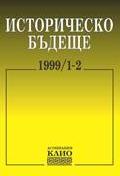Османската управленска номенклатура през XVI–XVII век (Монопол на девширметата върху властта - първи и втори етап)
Ottoman Administrative Nomenclature in the 16th and 17th Centuries. The Monopoly of the Devshirme Recruit System on Power: First and Second Phase
Author(s): Evgeniy RadoushevSubject(s): History
Published by: Асоциация Клио
Keywords: Ottoman Empire; Ottoman administrative nomenclature; devshirme system; the Jannissary Corps
Summary/Abstract: Historians seem to agree that centralization of power was a characteristic trait of the Ottoman socio-economic system. It is true that such processes as the development of industry and trade, the accumulation of capital, the emergence of social movements, etc. are basically not subject to management by the state administration. Nevertheless, the Ottoman state made a continuous effort to intervene with and direct the socio-economic processes in the country. In this respect, it seems to have achieved lasting results. While most historians tend to regard the Ottoman administration as an exception to the rule in the history of the Old Continent government tradition, it should be noted that the Ottoman state with its specific methods of management of the social and economic developments has its parallels even in twentieth-century societies. So far, the centralized government of the Ottoman empire has been studied mostly at an institutional level. At the same time, the underlying philosophic principles of the Ottoman government seem to have remained out of the scope of scholarly interest of modern historians. The present article attempts to throw some light on the problems relevant to the power structures of the Ottoman administration. For the specific purposes of his study, the author has coined the term "Ottoman administrative nomenclature". He pays special attention to the devshirme system as a main source of recruitment of military and administrative personnel. Further, he studies the role which this personnel played in the Ottoman state's political and economic life. This approach to the study of the Ottoman administration will help us gain insight into its political structure as well as into the factors that made it viable in a wide geographic area over a long period of time.
Journal: Историческо бъдеще
- Issue Year: 1999
- Issue No: 1-2
- Page Range: 3-44
- Page Count: 42
- Language: Bulgarian
- Content File-PDF

